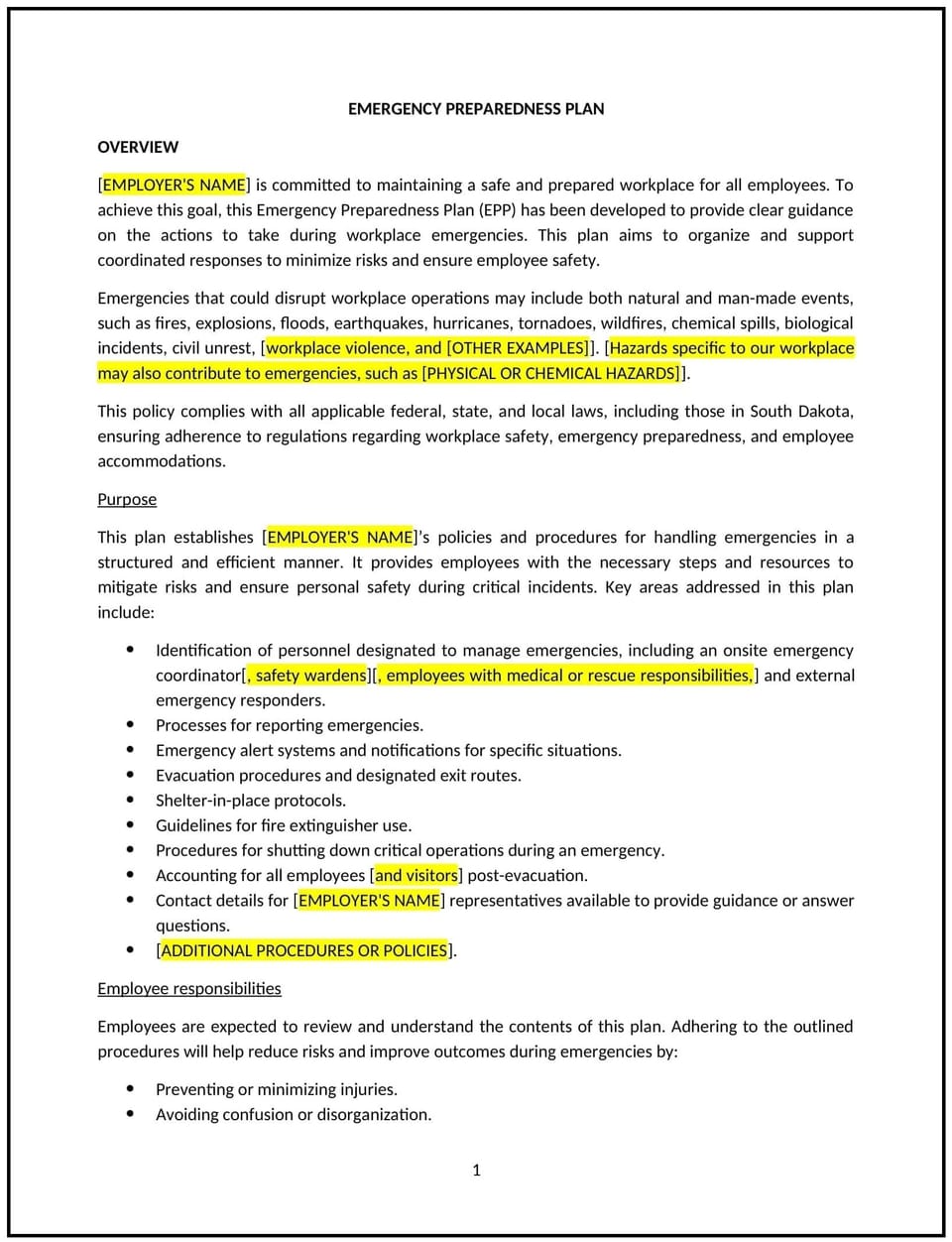Emergency preparedness plan (South Dakota): Free template

Emergency preparedness plan (South Dakota)
This emergency preparedness plan is designed to help South Dakota businesses develop strategies to manage emergencies, such as natural disasters, workplace accidents, or public health crises. It outlines procedures for safeguarding employees, minimizing disruptions, and improving compliance with South Dakota safety regulations.
By adopting this plan, businesses can promote safety, enhance operational resilience, and reduce risks during emergencies.
How to use this emergency preparedness plan (South Dakota)
- Identify potential emergencies: Outline scenarios such as severe weather, fires, medical emergencies, or security threats that could impact the workplace.
- Establish response procedures: Detail specific actions to take during each type of emergency, including evacuation routes, shelter locations, and communication plans.
- Assign roles and responsibilities: Designate employees responsible for specific tasks, such as coordinating evacuations or administering first aid.
- Provide training: Conduct regular drills and training sessions to ensure employees understand emergency protocols.
- Maintain emergency supplies: Stock essential items, such as first aid kits, flashlights, and emergency contact lists.
- Communicate clearly: Develop a communication plan for notifying employees, stakeholders, and emergency services during an incident.
- Review and update regularly: Ensure the plan reflects changes in South Dakota laws, workplace conditions, or emerging risks.
Benefits of using this emergency preparedness plan (South Dakota)
This policy provides several benefits for South Dakota businesses:
- Enhances safety: Protects employees, customers, and visitors during emergencies.
- Supports compliance: Aligns with South Dakota safety regulations and industry standards.
- Reduces downtime: Minimizes operational disruptions caused by emergencies.
- Builds confidence: Demonstrates the company’s commitment to employee and customer safety.
- Encourages readiness: Promotes a culture of preparedness and proactive risk management.
Tips for using this emergency preparedness plan (South Dakota)
- Communicate the plan: Share the plan with employees during onboarding and include it in internal resources.
- Provide training: Educate employees and managers on emergency procedures and the use of emergency equipment.
- Regularly update contact lists: Keep emergency contact information current for all employees and key stakeholders.
- Practice drills: Schedule routine emergency drills to ensure everyone is familiar with evacuation routes and safety protocols.
- Review annually: Update the plan to reflect changes in South Dakota laws, workplace conditions, or identified risks.
Q: What types of emergencies are covered under this plan?
A: This plan covers emergencies such as severe weather, fires, medical incidents, security threats, and public health crises that may impact the workplace.
Q: How should businesses prepare employees for emergencies?
A: Businesses should provide regular training, conduct emergency drills, and distribute clear guidelines to ensure employees understand their roles during an emergency.
Q: What are the key components of an emergency communication plan?
A: An emergency communication plan should include methods for notifying employees, contacting emergency services, and providing updates to stakeholders.
Q: How often should this plan be reviewed?
A: The plan should be reviewed annually or whenever significant changes occur in South Dakota laws, workplace conditions, or potential risks.
Q: What supplies should businesses maintain for emergencies?
A: Emergency supplies may include first aid kits, flashlights, batteries, bottled water, non-perishable food, and communication devices.
Q: Who is responsible for overseeing the emergency preparedness plan?
A: A designated safety officer or team should oversee the plan’s implementation, training, and regular updates.
Q: How can businesses minimize disruptions during emergencies?
A: Businesses can minimize disruptions by having clear response procedures, ensuring adequate training, and maintaining backup systems for critical operations.
Q: Are remote employees covered under this plan?
A: Yes, remote employees should be included, with guidance on how to respond to emergencies affecting their work environment.
This article contains general legal information and does not contain legal advice. Cobrief is not a law firm or a substitute for an attorney or law firm. The law is complex and changes often. For legal advice, please ask a lawyer.


